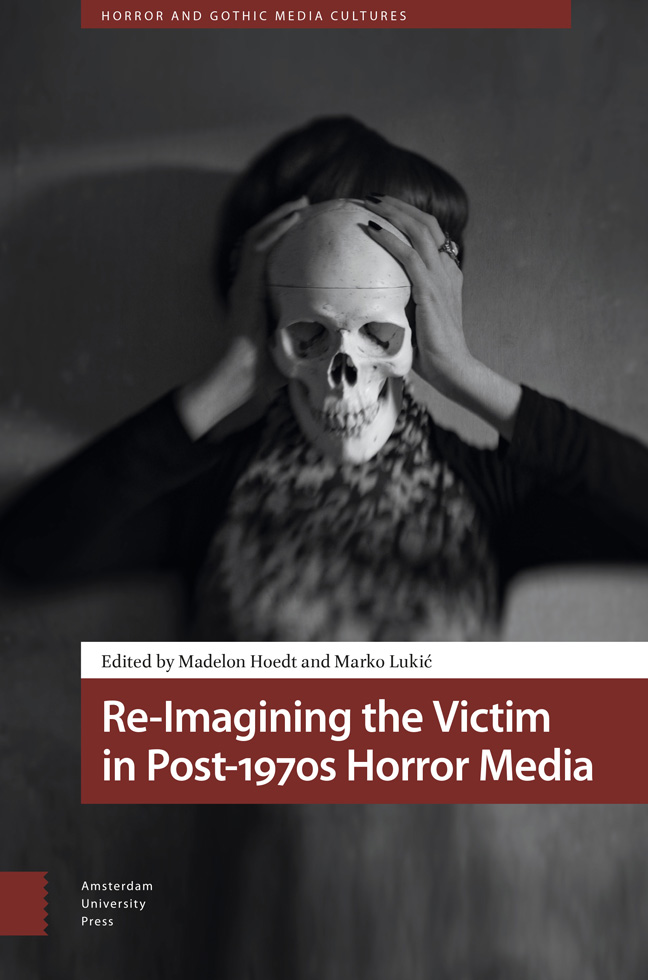Book contents
- Frontmatter
- Contents
- Introduction: Theorising the Victim
- 1 Opening the Gate: Reconfiguring the Child Victim in Stranger Things
- 2 Black Death: Black Victims in 1980s Teen Slashers
- 3 Beyond Binaries: The Position of the Transgender Victim in Horror Narratives
- 4 Through the Looking-Glass: The Gothic Victim in Jordan Peele’s Us
- 5 Postmortem Victimhood: Necrovalue in Phantasm and Dead and Buried
- 6 The Sad Killer: Perpetuating Spaces, Trauma and Violencewithin the Slasher Genre
- 7 “If this is the last thing you see… that means I died”: A Taxonomy of Camera-Operating Victims in Found Footage Horror Films
- 8 Victimhood and Rhetorical Dialectics within Clive Barker’s Faustian Fiction
- 9 Pain Index, Plain Suffering and Blood Measure: A Victimology of Driving Safety Films, 1955–1975
- 10 Biolithic Horror: Stone Victim/Victimisers in Resident Evil Village
- 11 The Potential Victim: Horror Role-Playing Games and the Cruelty of Things
- Bibliography
- Filmography
- Index
6 - The Sad Killer: Perpetuating Spaces, Trauma and Violencewithin the Slasher Genre
Published online by Cambridge University Press: 26 March 2024
- Frontmatter
- Contents
- Introduction: Theorising the Victim
- 1 Opening the Gate: Reconfiguring the Child Victim in Stranger Things
- 2 Black Death: Black Victims in 1980s Teen Slashers
- 3 Beyond Binaries: The Position of the Transgender Victim in Horror Narratives
- 4 Through the Looking-Glass: The Gothic Victim in Jordan Peele’s Us
- 5 Postmortem Victimhood: Necrovalue in Phantasm and Dead and Buried
- 6 The Sad Killer: Perpetuating Spaces, Trauma and Violencewithin the Slasher Genre
- 7 “If this is the last thing you see… that means I died”: A Taxonomy of Camera-Operating Victims in Found Footage Horror Films
- 8 Victimhood and Rhetorical Dialectics within Clive Barker’s Faustian Fiction
- 9 Pain Index, Plain Suffering and Blood Measure: A Victimology of Driving Safety Films, 1955–1975
- 10 Biolithic Horror: Stone Victim/Victimisers in Resident Evil Village
- 11 The Potential Victim: Horror Role-Playing Games and the Cruelty of Things
- Bibliography
- Filmography
- Index
Summary
Abstract
The analysis of the monstrous, particularly within slasher movies, follows a pattern in which a polarity between “good” and “bad” dominates the narrative, with the traditional heroine being forced to face violence, horror and trauma and her antagonist remaining a two-dimensional shape, bound to its role as an (inventive) killer. The proposed research will challenge this monstrous status by observing it through the prism of victimhood. By analysing film franchises such as Friday the 13th, A Nightmare on Elm Street and Halloween, the chapter will argue that a heterotopian spatial paradigm within the narratives helps identify a deeply rooted trauma within the antagonists and, in doing so, perpetuates the cycle of violence.
Keywords: spatiality, subversion, monstrous victimhood, counter-site, heterotopia, Foucault
The continuously evolving nature of the horror genre has been followed by a similarly paced critical discourse, where several themes and theoretical topics have become something of an academic staple over the years. Notions such as haunted houses, the consumerist-based readings directed at zombie narratives and the nearly omnipresent notion of otherness waiting to be modelled and inscribed with mixtures of horror and cultural anxieties dominate horror-oriented academia. However, one topic has remained particularly relevant since its introduction into the critical discourse in 1992 by Carol J. Clover. The concept of the Final Girl and her role within the slasher genre redefined the analysis and theoretical deconstruction of the monstrous, particularly within slasher movies, allowing a rather clear articulation of a pattern within which a polarity between “good” and “bad” strongly dominates the narrative. On the one hand, the traditional hero, or more likely the traditional heroine/Final Girl, is forced to face violence, horror and unavoidable trauma, resulting in a narrative arc dedicated to her suffering as well as her resilience. On the other hand, however, her antagonist remains a two-dimensional shape, bound to their role as an (inventive) killer and a metaphoric theoretical concept that allows for the articulation of the heroine’s identity. Following the initial status of the heroine as the indisputable victim within the genre, this analysis aims at addressing the possibility of an alternative reading of a series of famous horror narratives. More precisely, this research will explore the challenging of the monstrous killer’s status through the prism of victimhood.
- Type
- Chapter
- Information
- Re-Imagining the Victim in Post-1970s Horror Media , pp. 113 - 132Publisher: Amsterdam University PressPrint publication year: 2024

